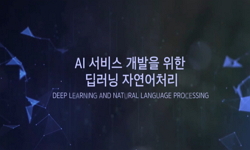본 연구에서는 감정을 표현하기 위한 표정 연습을 보조하는 인공지능을 개발하였다. 개발한 인공지능은 서술형 문장과 표정 이미지로 구성된 멀티모달 입력을 심층신경망에 사용하고 서술...
http://chineseinput.net/에서 pinyin(병음)방식으로 중국어를 변환할 수 있습니다.
변환된 중국어를 복사하여 사용하시면 됩니다.
- 中文 을 입력하시려면 zhongwen을 입력하시고 space를누르시면됩니다.
- 北京 을 입력하시려면 beijing을 입력하시고 space를 누르시면 됩니다.

감정 분류를 이용한 표정 연습 보조 인공지능 = Artificial Intelligence for Assistance of Facial Expression Practice Using Emotion Classification
한글로보기https://www.riss.kr/link?id=A108405883
- 저자
- 발행기관
- 학술지명
- 권호사항
-
발행연도
2022
-
작성언어
-
- 주제어
-
KDC
567
-
등재정보
KCI등재
-
자료형태
학술저널
-
수록면
1137-1144(8쪽)
- DOI식별코드
- 제공처
-
0
상세조회 -
0
다운로드
부가정보
국문 초록 (Abstract)
본 연구에서는 감정을 표현하기 위한 표정 연습을 보조하는 인공지능을 개발하였다. 개발한 인공지능은 서술형 문장과 표정 이미지로 구성된 멀티모달 입력을 심층신경망에 사용하고 서술형 문장에서 예측되는 감정과 표정 이미지에서 예측되는 감정 사이의 유사도를 계산하여 출력하였다. 사용자는 서술형 문장으로 주어진 상황에 맞게 표정을 연습하고 인공지능은 서술형 문장과 사용자의 표정 사이의 유사도를 수치로 출력하여 피드백한다. 표정 이미지에서 감정을 예측하기 위해 ResNet34 구조를 사용하였으며 FER2013 공공데이터를 이용해 훈련하였다. 자연어인 서술형 문장에서 감정을 예측하기 위해 KoBERT 모델을 전이학습 하였으며 AIHub의 감정 분류를 위한 대화 음성 데이터 세트를 사용해 훈련하였다. 표정 이미지에서 감정을 예측하는 심층신경망은 65% 정확도를 달성하여 사람 수준의 감정 분류 능력을 보여주었다. 서술형 문장에서 감정을 예측하는 심층신경망은 90% 정확도를 달성하였다. 감정표현에 문제가 없는 일반인이 개발한 인공지능을 이용해 표정 연습 실험을 수행하여 개발한 인공지능의 성능을 검증하였다.
다국어 초록 (Multilingual Abstract)
In this study, an artificial intelligence(AI) was developed to help with facial expression practice in order to express emotions. The developed AI used multimodal inputs consisting of sentences and facial images for deep neural networks (DNNs). The DN...
In this study, an artificial intelligence(AI) was developed to help with facial expression practice in order to express emotions. The developed AI used multimodal inputs consisting of sentences and facial images for deep neural networks (DNNs). The DNNs calculated similarities between the emotions predicted by the sentences and the emotions predicted by facial images. The user practiced facial expressions based on the situation given by sentences, and the AI provided the user with numerical feedback based on the similarity between the emotion predicted by sentence and the emotion predicted by facial expression. ResNet34 structure was trained on FER2013 public data to predict emotions from facial images. To predict emotions in sentences, KoBERT model was trained in transfer learning manner using the conversational speech dataset for emotion classification opened to the public by AIHub. The DNN that predicts emotions from the facial images demonstrated 65% accuracy, which is comparable to human emotional classification ability. The DNN that predicts emotions from the sentences achieved 90% accuracy. The performance of the developed AI was evaluated through experiments with changing facial expressions in which an ordinary person was participated.
목차 (Table of Contents)
- Ⅰ. 서론
- Ⅱ. 표정 연습 보조를 위한 인공지능 개요
- Ⅲ. 얼굴 이미지를 통한 감정 분류
- IV. 자연어를 통한 감정 분류
- V. 표정 연습 보조 인공지능의 개발 결과
- Ⅰ. 서론
- Ⅱ. 표정 연습 보조를 위한 인공지능 개요
- Ⅲ. 얼굴 이미지를 통한 감정 분류
- IV. 자연어를 통한 감정 분류
- V. 표정 연습 보조 인공지능의 개발 결과
- VI. 결론
- References
동일학술지(권/호) 다른 논문
-
스마트그리드 빅데이터 기반 지역별 배전선로 부하손실 분석
- 한국전자통신학회
- 조재훈(Jae-Hun Cho)
- 2022
- KCI등재
-
아두이노와 적외선 센서를 이용한 스마트 도어락과 앱 개발에 대한 연구
- 한국전자통신학회
- 전형준(Hyeomg-Jun Jeon)
- 2022
- KCI등재
-
가상현실 메타버스 디지털 성범죄 예방을 위한 플랫폼 구축 제안 연구
- 한국전자통신학회
- 황재원(Jae-Won Hwang)
- 2022
- KCI등재
-
- 한국전자통신학회
- 김철민(Cheol-Min Kim)
- 2022
- KCI등재




 ScienceON
ScienceON 스콜라
스콜라





